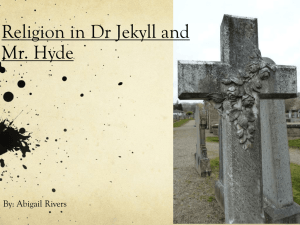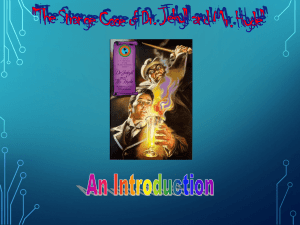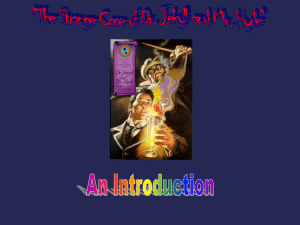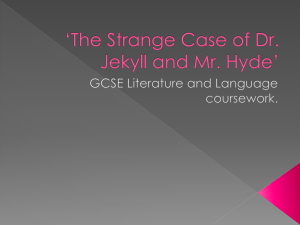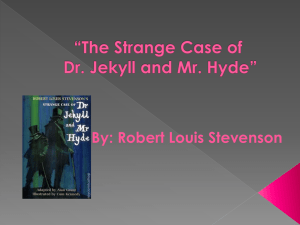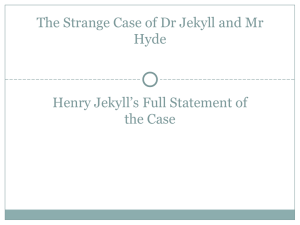Robert Louis Stevenson`s Jekyll and Hyde and the Double Brain
advertisement
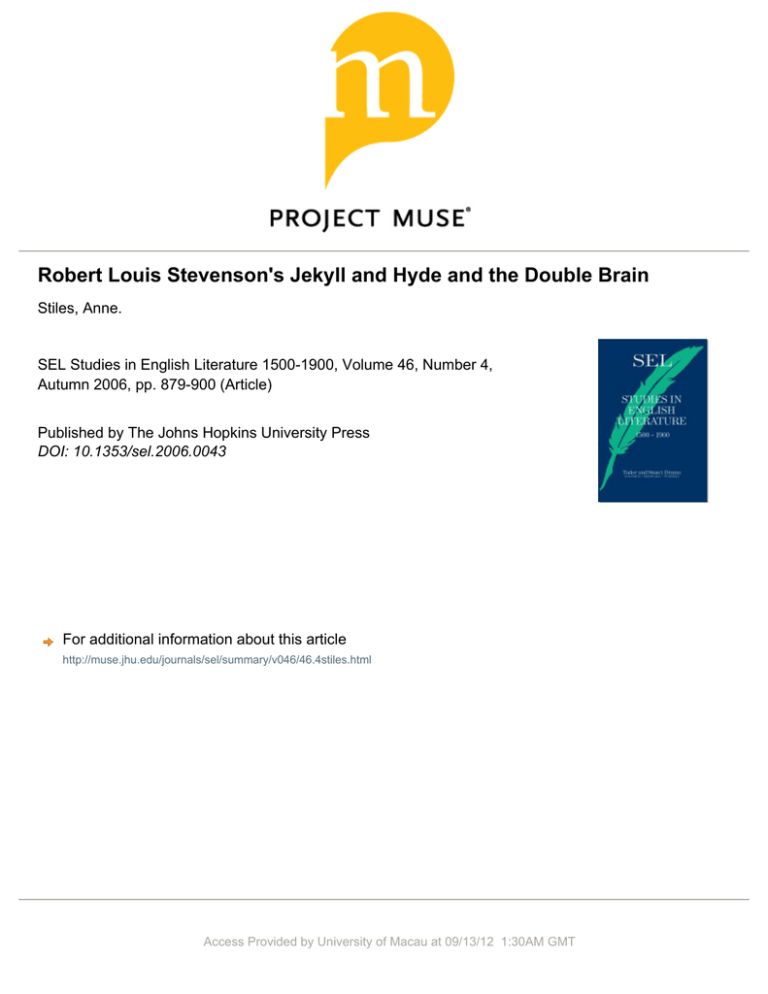
Robert Louis Stevenson's Jekyll and Hyde and the Double Brain Stiles, Anne. SEL Studies in English Literature 1500-1900, Volume 46, Number 4, Autumn 2006, pp. 879-900 (Article) Published by The Johns Hopkins University Press DOI: 10.1353/sel.2006.0043 For additional information about this article http://muse.jhu.edu/journals/sel/summary/v046/46.4stiles.html Access Provided by University of Macau at 09/13/12 1:30AM GMT SEL 46,Stiles 4 (Autumn 2006): 879–900 Anne ISSN 0039-3657 879 879 Robert Louis Stevenson’s Jekyll and Hyde and the Double Brain ANNE STILES In “The Decay of Lying: An Observation” (1889; rev. 1891), Oscar Wilde writes that “the transformation of Dr Jekyll reads dangerously like an experiment out of the Lancet.”1 This statement rings true on more levels than Wilde himself probably realized. Not only does Robert Louis Stevenson’s Strange Case of Dr. Jekyll and Mr. Hyde (1886) resemble contemporary medical case studies in its form and structure, but its core idea may also have originated from medical literature. In her 1905 introduction to Stevenson’s collected works, Fanny Osbourne Stevenson traces her spouse’s interest in dual personality to a specific scientific article: “[M]y husband was deeply impressed by a paper he read in a French scientific journal on sub-consciousness [sic].”2 This unnamed article, she adds, “gave the germ of the idea” that Stevenson afterward developed into Deacon Brodie, or, The Double Life (1880), a play he co-wrote with William Ernest Henley about the infamous eighteenth-century Scottish town councilor who led a secret nocturnal life of crime. Stevenson, we learn, then used this scientific inquiry again in his “Markheim” (1885), and, finally, “in a hectic fever following a hemorrhage of the lungs,” it “culminated in the dream of Jekyll and Hyde.” The possible existence of this unidentified “paper on . . . subconsciousness” jars with Stevenson’s own testimony, since the author himself flatly denied using any medical theories or particular case studies as models. In an 1893 interview, a journalist from New Zealand asked Stevenson, “Had you heard of any actual case of double personality before you wrote your book?” Stevenson Anne Stiles is a visiting scholar at the American Academy of Arts and Sciences in Cambridge, Massachusetts during the academic year 2006–07. In fall 2007, she will be assistant professor of English at Washington State University at Pullman. 880 Jekyll and Hyde responded, “Never . . . After the book was published I heard of the case of ‘Louis V.,’ the man in the hospital at Rochefort. Mr. [Frederic W. H.] Myers sent it to me.”3 One is initially tempted to take Stevenson’s account of the composition of Jekyll and Hyde more seriously than that of his spouse, not only because he was writing about these events at less remove (eight years after the composition of Jekyll and Hyde rather than twenty years) but also because Fanny’s testimony elsewhere in her introduction is not entirely reliable.4 Moreover, certain aspects of Stevenson’s account can be corroborated; he did correspond with Myers shortly after the publication of Jekyll and Hyde, and Myers undoubtedly sent him a copy of his 1886 article “Multiplex Personality,” which contains the case study of Louis V. mentioned by Stevenson. However, in light of striking correspondences between Stevenson’s work and case studies in French and British popular and medical journals during the 1870s and 1880s, it seems highly unlikely that Stevenson’s reply to the reporter was entirely honest. It may be, as Richard Dury speculates, that Stevenson “refuses to collaborate with the reporter because he does not wish to provide a single key to a story that is intended to remain enigmatic.”5 Stevenson critics including Dury, Jean-Pierre Naugrette, and Jacqueline Carroy have proposed various candidates for the “paper on sub-consciousness,” the most popular being a series of articles by Bordeaux physician Eugène Azam in Revue Scientifique in the 1870s.6 In these articles, Azam introduces his famous patient Félida X., whom Ian Hacking identifies as “[t]he first French double personality to be studied in depth.”7 While I agree that Azam’s Félida is one likely source, I believe that Stevenson had other case studies in mind as well, some of which were available to him in British rather than French periodicals, a possibility previous critics have overlooked. Stevenson was probably influenced by French physician Ernest Mesnet’s case study of a soldier (Sergeant F.) who developed two distinct personalities after his left cerebral hemisphere was damaged by a gunshot wound.8 The case studies of both Félida and Sergeant F. were translated and summarized by journalist and astronomer Richard Proctor in a series of articles appearing in the Cornhill Magazine during the late 1870s. Since Stevenson also contributed to the Cornhill during this time period, it is unlikely that these articles escaped his attention. I further suggest that Stevenson’s work does much more than simply reflect the case studies upon which it is loosely based. In fact, Stevenson’s masterpiece creatively intervenes in late-Victo- Anne Stiles 881 rian debates about dual personality and its alleged cause, bilateral brain hemisphere imbalance. For instance, Stanley Finger explains that Jekyll and Hyde “could well have affected how some clinicians subsequently viewed their cases,” suggesting that the case studies of dual and multiple personality reported by Myers in 1886 and Scottish psychiatrist Lewis Bruce in 1895 (and possibly many others) bear the mark of Stevenson’s influence.9 By virtue of his training and personal relationships with scientists, Stevenson was well-qualified to intervene in scientific controversies. The author came from a family of Scottish lighthouse engineers and studied engineering before turning to literature as a profession, meanwhile befriending scientific luminaries such as engineer Fleeming Jenkin and educational psychologist James Sully. He also corresponded sporadically with other important researchers, including Myers and the renowned French alienist Pierre Janet.10 Stevenson amply demonstrates his familiarity with the rhetorical conventions of scientific prose in Jekyll and Hyde. The novella cleverly parodies the form of the case study in order to reveal the weaknesses of late-Victorian narrative and theoretical models. This parody of the case study, however, takes place in the unlikely medium of the Gothic romance, the genre that critics most often associate with Jekyll and Hyde. Robert Mighall, for instance, sees Jekyll and Hyde as a model of “a new breed of Gothic fiction” that challenges realist notions of time, place, and context but still exhibits a marked “somatic and physiological character,” while Patrick Brantlinger places Stevenson in the category of lateVictorian “Gothic romancers, whose stories always veer toward dreams and the subliminal reaches of the mind.”11 By mimicking the case study within a Gothic romance, Stevenson lays bare the limitations of scientific prose, particularly its inadequacy in light of complex moral and social realities impossible to relate in purely empirical terms. One might conceptualize Jekyll’s “perennial war among [his] members,” then, as the doctor’s struggle to maintain scientific objectivity in the face of a terrifying subjective reality that threatens to overwhelm him.12 Stevenson was no mere satirist of scientific conventions, however; he clearly endorses particular scientific theories even as he implicitly mocks the rhetoric in which they are couched. The most likely origin of Stevenson’s conception of multiple personality disorder as it appears in Jekyll and Hyde is the theory of the double brain, first developed by Continental physiologists such as Austrian anatomist Franz Joseph Gall (1758–1828) and later 882 Jekyll and Hyde imported to England by such physicians as Sir Henry Holland (1788–1873) and Arthur Labroke Wigan (d, 1847) during the first half of the nineteenth century. “[M]an is not truly one, but truly two,” Jekyll relates, apparently supporting theories suggesting that each brain hemisphere might house a separate personality, indeed, a separate soul (p. 48). Jekyll’s lament that “these polar twins should be continuously struggling” likewise evokes contemporary scientific views that the left and right hemispheres not only differed in their abilities, but also occasionally exhibited contrasting desires and moral inclinations (p. 49). II. JEKYLL AND HYDE, LITERARY CRITICISM, AND LATE-VICTORIAN SCIENCE With a few prominent exceptions, critics of Jekyll and Hyde have overlooked dual-brain theories as potential sources for the novella’s central theme. Anne Harrington, in Medicine, Mind and the Double Brain: A Study in Nineteenth-Century Thought (1987), briefly mentions the relevance of brain duality to Jekyll and Hyde: “[O]ne would have to argue . . . that Jekyll would tend to focus his personality in the civilized, rational left hemisphere, while Hyde would give vent to his criminal instincts from somewhere in the recesses of the uneducated, evolutionarily backward right hemisphere.”13 Since Harrington’s excellent study is historical rather than literary, however, she necessarily leaves the narrative implications of Henry Jekyll’s duality unexplored. Elaine Showalter, too, briefly elaborates upon Harrington’s observations about Jekyll and Hyde, arguing that “the dominant side of the brain represent[s] the dominant gender, and the other the repressed gender.”14 Showalter’s invocation of the dual-brain theory is part of a queer critical reading of Stevenson’s narrative that draws not only on Harrington but also on Sigmund Freud and his contemporary Wilhelm Fliess, who “argued that all human beings were bisexual.”15 Yet, by orienting her discussion toward Freud and Fliess, Showalter’s discussion occludes the significant ways in which Stevenson’s novella sought to give literary intelligibility to late-Victorian psychological theories of the 1870s and 1880s that differed markedly from psychoanalytic understandings of the drives, as well as the conflict between the conscious and unconscious realms of psychic life. While late-Victorian scientific thought displayed a marked tendency toward biological determinism, Freud in his post-1895 work was less concerned with finding physiological causes for psychologi- Anne Stiles 883 cal ills (the preoccupation of Stevenson’s contemporaries) and more interested in formulating symbolic conceptions of mental dynamics.16 Showalter’s commentary is thus symptomatic of a larger body of Stevenson criticism in which Freud’s later works overshadow any late-nineteenth-century scientific sources from which Stevenson might have drawn.17 While there have been a few notable attempts to relate Stevenson’s novella to late-Victorian scientific sources, most of these commentaries likewise prove to be either anachronistic or incomplete. Stephen Heath, for example, has traced the motif of the double back to Richard von Krafft-Ebing’s Psychopathia Sexualis (1886), a founding work of modern sexology.18 But Heath fails to establish any historical link between Stevenson and KrafftEbing, whose work first appeared in English six years after the publication of Jekyll and Hyde. By comparison, Stephen D. Arata’s linkage of Jekyll and Hyde with Cesare Lombroso’s theories of the atavistic criminal and Max Simon Nordau’s Degeneration (1892; trans. 1895) is also potentially illuminating.19 But Nordau and Lombroso are also too late to have influenced Jekyll and Hyde; as Arata himself admits, “Lombroso’s work first reached a wide audience in England thanks to Havelock Ellis’s The Criminal (1891).”20 Meanwhile, Ed Block Jr. has linked Stevenson’s depiction of mental illness to evolutionary psychologist James Sully, who is best known for his studies of child psychology.21 Sully, however, addresses the topic of dual personality only briefly and indirectly in articles on subjects such as dreams, hypnosis, or hallucinations. More recently, Katherine Linehan’s 2003 Norton edition of Jekyll and Hyde has drawn readers’ attention to Myers’s article, “Multiplex Personality” (1886), as an important reference for understanding Stevenson’s story. Myers’s article does suggest brain duality as a possible cause for dual and multiple personalities, but the piece was published several months after Jekyll and Hyde and was more likely informed by Stevenson’s novella rather than the other way around.22 Moreover, the concept of “multiplex personalities” (defined as more than two separate personalities expressed in one individual) was first introduced in July 1885.23 The cases to which Stevenson refers appeared in the popular press in the mid 1870s when dual personalities were widely discussed, but multiplex personality had yet to be recognized as a clinical possibility. In recognizing the similarity between Jekyll’s “strange case” and Félida’s dual personalities, Dury, Naugrette, and Carroy come 884 Jekyll and Hyde closest to identifying the likely scientific source material for Jekyll and Hyde. However, these critics do not seem to be aware of how widely Félida’s case was discussed in the British press, nor do they mention Proctor’s articles in Cornhill as potential sources. More importantly, they do not thoroughly explore the crucial link between the concept of dual personality and the concept of bilateral brain hemisphere asymmetry. Taken together, these critical oversights demonstrate how scholars’ appeals to particular intellectual traditions, debates, and sources have been limited and involved some misapprehensions. Thus it makes greater sense to follow Harrington’s lead in order to explore how and why Stevenson proved so responsive to—though hardly uncritical of—theories of the double brain. III. THE DUAL-BRAIN THEORY The opposites embodied in the Jekyll/Hyde binary conform to late-Victorian ideas about the brain as a double organ, in ways that both Harrington and Showalter have helped to outline. On the one hand, we have “Henry Jekyll, M.D., D.C.L., LL.D., F.R.S., &c.” (p. 13), “the very pink of the proprieties” (p. 10). A respected, altruistic doctor, Jekyll appears a “large handsome,” “well-made, smooth-faced man of fifty” (pp. 20, 19). On the other hand, Edward Hyde is “abnormal and misbegotten,” exuding an ambiguous air of deformity (p. 45). Unlike Jekyll, Hyde appears young and effeminate by virtue of his diminutive stature, dandyish tastes, and emotional lability, including an outburst of “hysteria” (p. 45). Racially, Hyde is an ape-like evolutionary reversion sporting a “swart growth of hair” over the “dusky pallor” of his skin tone, in contrast to Jekyll’s “white” skin (p. 54). In other words, from a late-nineteenth-century perspective, Jekyll represents the pinnacle of evolution, while Hyde approaches its nadir. Variant versions of dual-brain theory circulating during the nineteenth century posited that the left and right hemispheres of the brain could function independently; according to this theory, everyone has two perfectly formed brains, each of which can substitute for the other in cases of unilateral brain injury. In the nineteenth century as now, the left brain was seen as the logical seat of reason and linguistic ability, contrasting with the emotional right brain.24 Predictably, most versions of dual-brain theory mediate Victorian race and gender biases. The left brain was associated with masculinity, whiteness, and civilization, while the right brain was the supposedly inferior or feminine seat of Anne Stiles 885 emotions, instincts, and the unconscious.25 The right hemisphere supposedly dominated in brains of women, savages, children, criminals, and the insane. While Jekyll exhibits left-hemisphere attributes (masculinity, whiteness, logic, intelligence, humanness), Hyde embodies right-hemisphere traits (femininity, racial indeterminacy, madness, emotion, and animality). Figuratively speaking, then, Stevenson’s Jekyll and Hyde performs a fictional corpus callosotomy, splitting the nerve fibers that connect two brain hemispheres, thereby giving each hemisphere an independent and unchecked life of its own.26 This figurative procedure exemplifies the surgical precision that Stevenson deemed necessary for the creation of believable fictional characters. The author confessed shortly before his death that “psychical surgery is, I think, a common way of ‘making character’: perhaps it is, indeed the only way . . . knife in hand, we must cut away and deduct the needless aborescence of [a character’s] nature.”27 This drastic mental split has moral consequences for Stevenson’s dual protagonist, ones that reflect contemporary theological debate surrounding the dual-brain theory. More than one Victorian scientist had been struck by the possibility that “so far as the brain represents it, the soul must be double.”28 Like these scientists, Stevenson explores the potentially heretical possibility that human beings are inherently double even in a healthy state. According to Jekyll’s narration, both he and Hyde existed before the discovery of the salt that enabled them to lead separate lives: “I learned to recognise the thorough and primitive duality of man; I saw that, of the two natures that contended in the field of my consciousness, even if I could rightly be said to be either, it was only because I was radically both” (p. 49). This passage locates humanity’s essential doubleness in the distant evolutionary past. Both the epithet “primitive” and the adverb “radically” (both of which mean, in this case, originary, at the root of) were used frequently in the emergent sciences of anthropology, geology, and the study of evolution during the latenineteenth century, often with racial overtones (denoting uncivilized, evolutionarily “backward” populations or “original” human populations from which modern races evolved). The proximity of these two words signals Stevenson’s familiarity with debates following in the wake of Charles Darwin’s Descent of Man (1871). At the same time, the passage apparently argues that duality is potentially consistent with mental health and not necessarily a symptom of insanity. 886 Jekyll and Hyde If mental and spiritual duality can coexist with mental health, then Jekyll’s madness must proceed from another cause: hemisphere imbalance. Victorian scientists often argued that dual (or multiple) personality disorders, along with other forms of insanity and criminality, resulted from an over-enlarged right brain overpowering the rational activities of the left brain. For example, in physiologist David Ferrier’s article “The Brain of a Criminal Lunatic” (1882), the autopsy of the brain of a mentally ill woman who had murdered her children revealed an over-enlarged right brain and a “strikingly abnormal . . . atrophied” left brain missing a frontal lobe (where speech and rational functions were thought to be located; Figure 1).29 Victorian scientists disagreed about whether such cases of hemisphere imbalance could be cured. While Henry Maudsley and other biological determinists denied this possibility, some moral managers asserted that the mentally ill could realign their imbalanced hemispheres. Making an analogy between muscular exertion and brain activity, these moral managers argued that using a given brain hemisphere promoted greater blood flow to that side of the brain. Various exercises were recommended for the purpose of strengthening one or both hemispheres. For instance, physiologist Charles Edouard Brown-Séquard suggested ambidextrous training for schoolchildren in 1874 in order to promote hemispheric balance.30 Stevenson’s protagonist evidently lacks both the early training and the self-regulatory ability necessary to balance his hemispheres. Initially, the left-brain Jekyll overmasters his animalistic right-brain urges, necessitating the creation of the hedonistic secondary persona. This secondary persona, Hyde, begins as the weaker of the two: “The evil side of my nature . . . was less robust and less developed than the good which I had just deposed. Again, in the course of my life, which had been, after all, nine tenths a life of effort, virtue and control, it had been much less exercised and much less exhausted. And hence, as I think, it came about that Edward Hyde was so much smaller, slighter and younger than Henry Jekyll” (p. 51). In Brown-Séquard’s terms, the persona embodying Jekyll’s “evil side” is smaller and less robust because it is underused; Hyde represents the atrophied, stunted right hemisphere struggling to break free of the restraints imposed by the dominant left brain. Predictably, Hyde increasingly predominates once he is unleashed with greater frequency. Jekyll’s narration suggests an awareness of what generally happens when a hemisphere is used Anne Stiles 887 Figure 1. Diagram shows underside of brain. Notice that the left side of the brain has atrophied considerably. Source of diagram: David Ferrier, “The Brain of a Criminal Lunatic,” Brain: A Journal of Neurology 5, 1 (April 1882): 62–73, 67, by permission of Oxford University Press. with greater frequency (i.e., a greater flow of blood goes to that side of the brain): “[I]t had seemed to me of late as though the body of Edward Hyde had grown in stature, as though (when I wore that form) I were conscious of a more generous tide of blood; and I began to spy a danger that, if this were much prolonged, the balance of my nature might be permanently overthrown” (p. 55). Jekyll’s predictions are vividly realized by his eventual inability to “throw off” the body of Edward Hyde (p. 55). From the perspective of moral managers such as Wigan or Brown-Séquard, Jekyll initially relies too heavily on his left hemisphere, and then shifts the balance too sharply toward the right. In each instance, he inadvertently creates the brain asymmetry that leads to his mental illness and criminality. Physicians diagnosed hemisphere imbalance by looking for telltale bodily symptoms such as left-handedness, signs which also surface in Jekyll and Hyde. Then as now, scientists thought that the left and right sides of the body were connected with 888 Jekyll and Hyde opposite hemispheres of the brain. Bodily left-sidedness (like left-handedness or left-leg predominance) signaled right-brain hemisphere dominance, which supposedly caused moral weakness and insanity. Hyde’s left-handed tendencies, demonstrated in his backward-sloping handwriting, thus present perhaps the strongest evidence of his right-brain dominance. Jekyll explains that “by sloping my own hand backward, I had supplied my double with a signature, [and] I thought I sat beyond the reach of fate” (p. 53). Myers wrote to Stevenson that “Hyde’s writing might look like Jekyll’s done with the left hand.”31 If Hyde writes with his left hand while Jekyll uses his right hand, then this fact definitively links the two personalities with the right and left hemispheres of the brain, respectively. IV. JEKYLL AND HYDE AS GOTHIC CASE STUDY Students of Stevenson’s works have long acknowledged that Jekyll and Hyde is neither the first nor the only place where Stevenson explores the motif of the double life, which is so closely linked in his oeuvre with theories of the dual brain. Earlier works such as Deacon Brodie and “Markheim” likewise grapple with the scientific and moral aspects of double lives. 32 But as I hope my discussion so far has suggested, Jekyll and Hyde embraces contemporary scientific theories with remarkable thoroughness, containing an altogether more explicit address to medical inquiries than we find in these earlier works by Stevenson. After all, the novella’s full title, Strange Case of Dr. Jekyll and Mr. Hyde, explicitly invites us to read the work as a scientific case study. At first glance, however, this novella’s relationship to the case history is far from obvious because of its recognizably Gothic conventions: the nocturnal setting, the theme of monstrosity, and the embedded narratives (such as fragments, found manuscripts, and letters). It is of course well-known that Jekyll and Hyde, in exploiting these narrative features that date back at least to the time of William Thomas Beckford (1760–1844), belongs to the distinctive late-Victorian revival of the Gothic. As critics such as Mighall have explained, the Gothic emphasis on psychological interiority and emotion might initially seem at odds with the eminently rational aims of the scientific case study. Mighall suggests that Gothic “horror fiction has a generic obligation to evoke fear or suggest mystery,” whereas “science . . . attempts to contain fear and offer a rational explanation for all phenomena.”33 Anne Stiles 889 Likewise, while the dual-brain theory Stevenson invokes was a late-Victorian scientific commonplace, one must keep in mind that the figure of the double is itself a Gothic convention. One thinks, for instance, of James Hogg’s The Private Memoirs and Confessions of a Justified Sinner (1824), Charles Robert Maturin’s Melmoth the Wanderer (1820), or even Mary Shelley’s Frankenstein (1818), in which the monstrous creature enacts his creator’s darkest desires. In some respects, Jekyll and Hyde strongly resembles Frankenstein, but significantly differs in that it relocates the familiar Gothic topos of the ancestral home and transforms it into the space of the urban laboratory. Despite—and sometimes because of—its conformity to certain Gothic conventions, the novella succeeds in mimicking and critiquing the exceedingly rational form of the case study through its seemingly dispassionate narrative voice. In scientific journals of the period, such as Mind (1876–present) or Brain: A Journal of Neurology (1878–present), the typical case study commences with an ostensibly objective third-person narrative, written by one or more scientists, with anecdotal and numerical evidence and illustrations appended toward the end of the piece. Similarly, Stevenson’s novella starts out with a third-person narrator writing mainly from the point of view of Gabriel John Utterson, the lawyer whose rational detective work can be likened to the research of a scientist-author. The letters from Hastie Lanyon and Henry Jekyll at the end of the novella resemble the concrete data placed toward the end of the traditional nineteenth-century case study. Thus, the fragmentary, epistolary structure of the Gothic novella in this instance neatly coheres with the traditional components of the case study. Yet the apparent resemblance between Stevenson’s romance and the case studies in medical journals from this period manages to disclose a chink in the armor of late-Victorian scientific objectivity. Using anecdotal accounts of patients’ histories, scientific authors constructed narratives suspiciously akin to fictitious productions. In Stevenson’s well-known critiques of realist prose written during the early 1880s, he chips away at distinctions that he says falsely differentiate fictional narratives from those supposedly based on objective truths: “[I]n every biography with any salt of life . . . in every history where events and men, rather than ideas, are presented . . . the novelist will find many of his own methods most conspicuously and adroitly handled.”34 Stevenson does not add the case study to his examples of histories and biographies that use “the same technical manoeuvres” as works of 890 Jekyll and Hyde fiction.35 But elsewhere in his literary critical essays, Stevenson suggests that scientists and literary writers share certain methodologies, even denouncing realist novelists for their “scientific thoroughness.”36 He argues that such authors willfully “dissect, with the most cutting logic, the complications of life, and of the human spirit.”37 If realists are brutal vivisectors, then Stevenson and other authors of romances likewise operate according to scientific methodologies, principally mathematical rather than biological ones. Stevenson writes of “a common and organic law” uniting “the highest achievements of the art of words,” further suggesting that this law might be geometric: “The arts, like arithmetic and geometry, turn away their eyes from the gross, coloured and mobile nature at our feet, and regard instead a certain figmentary abstraction . . . a proposition of geometry is a fair and luminous parallel for a work of art.”38 While “[g]eometry will tell us of a circle, a thing never seen in nature,” the romance will likewise describe idealized events rather than truthful facts: “those things which [the author] has only wished to do, than of those which he has done.”39 Stevenson, then, is no mere Luddite, but one who distinguishes between different scientific methodologies available to authors of case studies, on the one hand, and authors of fiction, on the other hand. He implies that the detached rationality of the scientific author or realist novelist pales beside the idealized abstractions of the mathematician or the author of romances. Stevenson’s musings on literary forms suggest what he might stand to gain from writing a romance about a scientist who struggles to maintain his objectivity. The shift from omniscient narration at the beginning of the novella to the epistolary fragments that make up its concluding chapters parallels Jekyll’s transition from objective physician to abject patient. Michel Foucault memorably observes that in the nineteenth century “[t]he locus in which [scientific] knowledge is formed” was not in the individual consciousness of a particular doctor, but rather in “a generalized medical consciousness, diffused in space and time, open and mobile, linked to each individual existence.”40 This dream of a transcendent medical objectivity, reflected in the omniscient narrator present for the first two-thirds of the novella, finally crumbles when Lanyon’s and Jekyll’s individual accounts take over the narrative. The breakdown of objectivity dramatized in the novella’s narrative form and in Jekyll’s mental collapse demonstrates the ultimate triumph of the subjective Gothic romance over the imperiously objective case study or realist novel. Anne Stiles 891 Noticeably, in Jekyll’s last confession, the doctor hopelessly confuses the boundaries between objective observation and subjective experience. “Henry Jekyll’s Full Statement of the Case” shifts between the first and third person, particularly in reference to Hyde: “He, I say—I cannot say, I” (p. 59). Unsure even of his pronoun usage, Jekyll is finally divested of the armature of his scientific vocabulary and revealed as a lost soul. In his final letter, Henry Jekyll offers himself up as a case study to be observed by the penetrating gaze of fellow scientists. With this gesture, Jekyll becomes, as Foucault suggests, one “of those who unmask” rather than one of “those before whom one unmasks”; he becomes the patient, rather than the physician.41 Through this role reversal, Stevenson questions the power structures of the nineteenthcentury medical establishment, particularly the inflexible divide between observer and observed, practitioner and patient. In other words, Stevenson does not merely reproduce the typical form of the case study, which was generally dry, unemotional, and detached from the patient’s suffering. Stevenson combines the basic structure of the case study with a tone and subject matter more appropriate to the Gothic, so that his novella suffers from a case of split personality like that of the protagonist himself. The logical, left-brain perspective of science combines with the primitive, emotional, right-brain perspective of the Gothic, demonstrating how Stevenson incorporates the polarities of the dual-brain theory into the literary form of his famous novella. V. FÉLIDA X. AND SERGEANT F. One might reasonably ask where exactly Stevenson came into contact with these theories of the double brain that resonate throughout the Gothic case study that is Jekyll and Hyde. As the novella’s full title suggests, Stevenson probably drew upon particular cases of dual personality, a disorder often explained by late-Victorian physiologists in terms of bilateral hemisphere imbalance. The cases of Félida X. and Sergeant F., initially reported by French physicians Azam and Mesnet, were popularized in England by astronomer and journalist Proctor. Critical neglect of Proctor’s writings has masked important aspects of both his professional career and Stevenson’s tale.42 In his Cornhill Magazine articles “Have We Two Brains?” (1875) and “Dual Consciousness” (1877), Proctor introduces Félida, a young hysteric who exhibited “a peculiar secondary state of mind” alternating with her “normal” personality.43 In her so-called normal 892 Jekyll and Hyde state, Félida appeared “melancholy” and “very anxious about her bodily health.”44 In her second state, meanwhile, Félida was observed “smiling gaily . . . and scarcely complain[ing] of any of the pains she had suffered so severely a few minutes before. She busied herself about the house, paid calls, and behaved like a healthy young girl.”45 Surprisingly, Félida’s disease transformed her from a morose hypochondriac into a paragon of domestic virtue. Her change initially resembles Jekyll’s, when the “younger, lighter, happier” Hyde succeeds his repressed and serious double (p. 50). Like Hyde’s fateful change, however, Félida’s transformation into her second state had unfortunate moral consequences. Proctor relates that Félida’s “power of self-control . . . was manifestly weaker during her second condition.”46 While Proctor remains vague about Félida’s misdeeds, Azam’s original account relates that she became pregnant out of wedlock during her condition seconde: “A young man of 18 to 20 years of age knew Félida X. . . . the two young people had a great affection for one another, and were promised to one another in marriage. During her second condition, she abandoned herself to him and became pregnant. During her period of normal life, she ignored him.”47 Félida’s sexual abandon in her second state does not obviously resemble Hyde’s violent sprees. Stevenson’s critics, however, have speculated that Jekyll’s unnamed “irregularities” may be sexual transgressions, and that Hyde’s violence substitutes for “something unsuitable for fiction”—i.e., sexual misconduct.48 Thus, Hyde’s ambiguous misdeeds probably mirror the sexual excesses of Félida’s second state. Stevenson’s deliberate choice of a male protagonist rather than a female one naturally changes the gender politics of the situation, however, so that Hyde becomes a sexual predator (“lusting to inflict pain”) rather than a fallen woman (p. 59; my emphasis). A potentially more crucial similarity between Félida X. and Jekyll is the manner in which they transform from one state into another. When Félida is changing states, she experiences “[s]harp pains attack[ing] both temples, and in a few moments she became unconscious. This lasted ten minutes.”49 Sergeant F. experienced similar symptoms: “The commencement of the abnormal state is ushered in by uneasiness and a sense of weight about the forehead” followed by “dulness [sic] and heaviness of the head.”50 When Jekyll takes the fateful powder, his symptoms resemble those mentioned above: “The most racking pangs succeeded: a grinding in the bones, deadly nausea, and a horror of the spirit Anne Stiles 893 that cannot be exceeded at the hour of birth or death. Then these agonies began swiftly to subside, and I came to myself as if out of a great sickness” (p. 50). Later, when Jekyll changes into Hyde spontaneously, he feels “a qualm . . . a horrid nausea and the most deadly shuddering. These passed away, and left me faint” (p. 58). On both occasions, there occurs a pleasant “change in the temper of my thoughts” after the physical agony subsides (p. 58). Not only do the physical symptoms resemble Félida’s, but the immediate psychological results of Jekyll’s transformation into Hyde also mirror Félida’s carefree abandon during her condition seconde. The increasing duration of their physical transformations also links Jekyll and Félida, as Dury notes; both “cases” exhibit “the growing and possibly complete dominance of the second personality-state.”51 At least one contemporary reader of Stevenson’s novella recognized the similarity between its dual protagonist and lateVictorian cases of multiple personality disorder, particularly the symptoms that occur when a patient changes personalities. In a letter to Stevenson, Myers complimented the author on his portrayal of Jekyll’s transformation, but suggested that “there must have been a loss of consciousness” and that the first time “might last for some hours,” followed by “more physical exhaustion.”52 Extended loss of consciousness and subsequent fatigue characterize Félida’s and Sergeant F.’s transformations, but not Jekyll’s. Myers’s comments demonstrate his own familiarity with the case of Félida X. (whom he would later describe, along with Louis V., in “Multiplex Personality”) and show that he urged Stevenson to make his novella conform more fully to contemporary scientific accounts of dual and multiple personality. That Myers appears to have understood Stevenson’s story as a fictionalization of such case studies as Félida’s and Sergeant F.’s is powerful evidence that Stevenson actually used these models. The case study of Sergeant F., likewise described by Proctor in his Cornhill publications, first aroused scientific interest when Thomas Huxley discussed it in his controversial 1874 lecture, “On the Hypothesis that Animals are Automata, and Its History.” Unlike Félida, whose disorder was naturally occurring, Sergeant F. developed two personalities as a result of a gunshot wound in the left brain hemisphere. In his “normal” state, Proctor writes, “the ex-sergeant’s health is perfect; he is intelligent and kindly, and performs satisfactorily the duties of a hospital attendant.”53 In his second or abnormal state, however, the sergeant displays animalistic, automatic qualities, along with altered sensory im- 894 Jekyll and Hyde pressions. At such times, he indifferently consumes “whatever is offered . . . asafœtida, or vinegar, or quinine, as readily as water,” and allows pins to be run through his body “without causing the least indication of pain.”54 Because of this insensitivity to pain and unpleasant tastes, Proctor characterizes Sergeant F. in his second state as machinelike or bestial. The animality common to both Hyde and Sergeant F. extends to their diminished moral faculties: In the unfortunate subjects of such abnormal conditions of the brain, the disturbance of the sensory and intellectual faculties is not unfrequently accompanied by a perturbation of the moral nature which may manifest itself in a most astonishing love of lying for its own sake. And in this respect, also, F.’s case is singularly instructive, for although in his normal state he is a perfectly honest man, in his abnormal condition he is an inveterate thief, stealing and hiding away whatever he can lay hands on, with much dexterity, and with an absurd indifference as to whether the property is his own or not. Hoffmann’s terrible conception of the ‘Doppelt-gänger’ [sic] is realised by men in this state, who live two lives, in the one of which they may be guilty of the most criminal acts, while in the other they are eminently virtuous and respectable. Neither life knows anything of the other.55 Here we have the basic structuring concept behind Stevenson’s Jekyll and Hyde, whose protagonist increasingly oscillates between bourgeois and criminal personalities.56 The above passage also highlights the similarities between dual personality and hysteria, both stereotypically feminine diseases and frequently comorbid conditions (that is, illnesses tending to occur simultaneously in the same patient populations, such as diabetes and hypertension). Mark Micale relates how the hysteric, like the aforementioned cases of dual personality, had long been characterized in medical literature and popular lore as “a deceitful, adulterous, sexually treacherous creature: the hypererotic hysteric.”57 Sergeant F.’s “love of lying for its own sake” as well as Félida’s sexual abandon remind us of the same qualities in Hyde, effectively demonstrating that dual personalities could emasculate the male sufferer. The following section further elucidates how the social and sexual role reversals in Jekyll and Hyde contribute to Stevenson’s polemical critique of late-Victorian medicine. Anne Stiles 895 VI. STEVENSON’S INTERVENTION INTO CONTEMPORARY PSYCHOLOGY Despite the compelling similarities between Stevenson’s fictional Strange Case and Proctor’s scientific case studies, Stevenson did not merely fictionalize Proctor’s material. By making his diseased protagonist a physician, Stevenson ironizes the power relations of nineteenth-century medicine. Moreover, his focus on the “strange case” of a male professional implicitly attacks the prerogatives of a patriarchal institution that for the most part (“Sergeant F.” notwithstanding) treated female subjects. Showalter explains that “[b]y the middle of the nineteenth century, records showed that women had become the majority of patients in public lunatic asylums.”58 This was particularly true of cases of double and multiple personality disorder, the overwhelming majority of which were women.59 In a century that constructed madness as stereotypically feminine, male doctors appeared “not only as the possessors, but also as the dispensers, of reason, which they can at will mete out to—or take away from—others.”60 Stevenson’s male doctor struggling to repress the feminine elements within himself destabilizes the paradigmatic power relations between male physician and female patient, as well as the identification of women with madness that Showalter so thoroughly elucidates. Stevenson’s protagonist, then, not only inverts the sexual hierarchy upon which clinical investigations were built, but also casts doubt on the claims to objectivity upon which the late-Victorian case study had come to rest. As Jan Goldstein observes, nineteenth-century medical writing normally maintained a strict objectivity that prevented any identification with the patient: “[T]he psychiatrist was not supposed to recognize the ‘diseased’ aspects of the patient in himself. A psychiatric diagnosis was in the nineteenth century something that a doctor gave to the patient as an ‘other.’ Not until the advent of psychoanalysis would subjectivity be valorized as an appropriate instrument of medical-scientific investigation.”61 In Stevenson’s tale, by contrast, the doctor is the patient whose split subjectivity overwhelms his “Full Statement of the Case,” making it difficult to tell whether it is Jekyll or Hyde who inscribes the “I” or the “he” of this document (pp. 47–62).62 The clinician’s penetrating gaze has turned inward upon himself, fracturing him into two selves and upending the entrenched power structures of the medical establishment in the process. Stevenson thus turns the tables upon the male professionals who sought to treat their patients dispassionately, revealing the limitations of the ways in which clinicians constructed their 896 Jekyll and Hyde “case.” Although Stevenson produced his critique of the case study ten years prior to Freud’s development of psychoanalysis, he anticipates Freud’s methods by exploring how a patient’s split subjectivity might be incorporated into an ostensibly objective clinical report. As Hacking points out, psychological case studies after Freud began to take on a new shape that posed fresh obstacles to the Foucauldian ideal of an objective medical collectivity: “Therapies, especially abreactive therapies, involve a relation between patient and therapist; what are we to make of the case reports when we know that the reporter is not a passive witness but an active agent in the case?”63 One might argue that Stevenson’s novella dramatizes the same question in a unique and compelling manner, by housing “passive witness” and “active agent” in the same physical body. Jekyll and Hyde can be read as a highly informed, daring critique of some of the nineteenthcentury’s most revered assumptions about the diagnosis and classification of medical subjects, as well as a literary harbinger of crucial innovations in modern psychiatry.64 NOTES 1 Oscar Wilde, “The Decay of Lying: An Observation,” in The Soul of Man Under Socialism and Selected Critical Prose, ed. Linda Dowling (New York: Penguin, 2001), pp. 163–92, 167. 2 [Fanny Osbourne Stevenson], “Prefatory Note,” in Robert Louis Stevenson, The Strange Case of Dr. Jekyll and Mr. Hyde: Fables, Other Stories and Fragments (London: Heinemann, 1924), pp. xv–xviii, xvi. This version was reprinted from a 1905 preface to Stevenson’s collected works published by Charles Scribner’s Sons. 3 “Mr. R. L. Stevenson on Reading and Literature: An Interview,” Argus, 11 April 1893. Quoted in Richard Dury, “Crossing the Bounds of Single Identity: Dr. Jekyll and Mr. Hyde and a Paper in a French Scientific Journal,” in Robert Louis Stevenson, Writer of Boundaries (Madison: Univ. of Wisconsin Press, 2006), pp. 237–51, 237. The author would like to thank Professor Dury for generously providing a copy of this manuscript before it was published. 4 Dury explains, “[L]ater in the preface . . . [Fanny] claims that the tale was written in three days and rewritten in another three, while Stevenson tells us that it was written over a space of about six weeks” (p. 239). 5 Dury, p. 248. 6 Jean-Pierre Naugrette has highlighted the correspondences between Félida and Jekyll in “Le texte et son double: Le cas de M.P. et du Dr. Forsyth,” Otrante 8 (Winter 1995–96): 149–59; and Naugrette, “L’Étrange cas du doutor Pereira et du docteur Cardoso: Essai sur la fonction cognitive et politique d’un mythe littéraire,” in La Dimension Mythique de la Littérature Contemporaine, ed. Ariane Eissen and Jean-Paul Engélibert, La Licorne 55 (Poitiers : UFR Langues Littératures, 2000), pp. 277–92. See also Jacqueline Carroy, Anne Stiles 897 Hypnose, suggestion et psychologie: “L’invention de sujets” (Paris: Presses Universitaires de France, 1991), pp. 103–9; “Entre mémoire et oubli: Les deux vies de Félida,” Revue Internationale de Psychopathologie 5 (February 1992): 73–80; and “Le savant et ses doubles. Docteurs Jekyll et Misters Hyde du siècle dernier,” Frénésie 10 (Spring 1992): 125–42. 7 Ian Hacking, “Automatisme Ambulatoire: Fugue, Hysteria, and Gender at the Turn of the Century,” MoMo 3, 2 (April 1996): 31–43, 38. 8 This particular case was first reported by Ernest Mesnet in De l’automatisme de la mémoire et du souvenir dans le somnambulisme pathologique: Considérations médico-légales (Paris: Imprimerie de Félix Malteste, 1874). 9 Stanley Finger, Minds Behind the Brain: A History of the Pioneers and Their Discoveries (New York: Oxford Univ. Press, 2000), p. 151. 10 On Stevenson’s correspondence with Pierre Janet, see Hacking, Rewriting the Soul: Multiple Personality and the Sciences of Memory (Princeton: Princeton Univ. Press, 1995), p. 278n. 11 Robert Mighall, A Geography of Victorian Gothic Fiction: Mapping History’s Nightmares (New York: Oxford Univ. Press, 1999), p. 138. Patrick Brantlinger, Rule of Darkness: British Literature and Imperialism, 1830–1914 (Ithaca and London: Cornell Univ. Press, 1988), p. 245. 12 Robert Louis Stevenson, Strange Case of Dr. Jekyll and Mr. Hyde, ed. Katherine Linehan (New York: Norton, 2003), p. 48. Further references to this source will be cited parenthetically within the essay. 13 Anne Harrington, Medicine, Mind and the Double Brain: A Study in Nineteenth-Century Thought (Princeton: Princeton Univ. Press, 1987), p. 136. 14 Elaine Showalter, “Dr. Jekyll’s Closet,” in The Haunted Mind: The Supernatural in Victorian Literature, ed. Elton E. Smith and Robert Haas (London: Scarecrow Press, 1999), p. 75. Showalter devotes only two paragraphs to the subject of the dual brain. 15 Showalter, “Dr. Jekyll’s Closet,” p. 75. 16 James Strachey, Freud’s English translator, writes that in Freud’s early works such as Project for a Scientific Psychology (1895) or Studies on Hysteria (1895), Freud “intended to make it possible to describe mental events in purely neurological terms. This attempt culminated in the ‘Project’ and was not long afterwards abandoned” (James Strachey, introduction to Josef Breuer and Sigmund Freud, Studies on Hysteria, trans. and ed. James Strachey [New York: Basic Books, 1957], pp. ix–xxviii, xxiv). 17 Other notable Freudian readings of Stevenson’s work include William Veeder, “Children of the Night: Stevenson and Patriarchy,” in Dr. Jekyll and Mr. Hyde after One Hundred Years, ed. William Veeder and Gordon Hirsch (Chicago: Univ. of Chicago Press, 1988), pp. 107–60; and Hilary J. Beattie, “Father and Son: The Origins of Strange Case of Dr. Jekyll and Mr. Hyde,” The Psychoanalytic Study of the Child 56 (2001): 317–60. Both of these particular readings examine Stevenson’s work in light of Freud’s oedipal theories, developed in Three Essays on the Theory of Sexuality (1905). 18 Stephen Heath, “Psychopathia sexualis: Stevenson’s Strange Case,” CritQ 28, 1 and 2 (Spring–Summer 1986): 93–108. 19 Stephen D. Arata, “The Sedulous Ape: Atavism, Professionalism, and Stevenson’s Jekyll and Hyde,” Criticism 37, 2 (Spring 1995): 233–59. 20 Arata, p. 234. 898 Jekyll and Hyde 21 Ed Block Jr., “James Sully, Evolutionist Psychology, and Late Victorian Gothic Fiction,” VS 25, 4 (Summer 1982): 443–67. 22 Frederic W. H. Myers’s letters to Stevenson shortly after the publication of Jekyll and Hyde show how deeply the novella impressed him. Myers to Stevenson, 21 February 1886–17 April 1887, in Robert Louis Stevenson: The Critical Heritage, ed. Paul Maixner (Boston: Routledge, 1981), pp. 212–22. 23 Hacking, Rewriting the Soul, p. 172. 24 Theories of bilateral hemisphere asymmetry have changed little in the past one hundred years, with some prominent exceptions. For instance, scientists now think that linguistic functions and mathematical reasoning may involve both hemispheres to some extent, and that women are predominantly left-brained. See Sally P. Springer and Georg Deutsch, Left Brain, Right Brain: Perspectives from Cognitive Neuroscience, 5th edn. (New York: W. H. Freeman, 1997), especially chap. 3. 25 Harrington, p. 100. 26 Corpus callosotomy, also called callosal section, is a surgical procedure used to treat severe epileptic seizures since the mid-twentieth century. 27 Stevenson, “My First Book” (1894), in Treasure Island, ed. Emma Letley (New York: Oxford Univ. Press, 1985), pp. 192–200, 195. 28 G. Stanley Hall and E. M. Hartwell, “Bilateral Asymmetry of Function,” Mind 9, 33 (January 1884): 93–109, 102. 29 David Ferrier, “The Brain of a Criminal Lunatic,” Brain: A Journal of Neurology 5, 1 (April 1882): 62–73, 64, 66. 30 Richard Proctor, “Have We Two Brains?” Cornhill Magazine 31, 182 (February 1875): 149–66, 165. 31 Myers’s emphasis. Myers to Stevenson, 27 February 1886, in Maixner, ed., p. 215. 32 Linehan, for instance, includes the short story “Markheim” in her Norton Critical Edition of Jekyll and Hyde because “[t]he two tales bear comparison for . . . their interest in drawing readers into the haunted consciousness of a murderer” (p. xiv). Masao Miyoshi likewise groups together Deacon Brodie, “Markheim,” and Jekyll and Hyde as works that demonstrate “Stevenson’s preoccupation with the theme of man’s double nature” (“Dr. Jekyll and the Emergence of Mr. Hyde,” CE 27, 6 [March 1966]: 470–80, 474). 33 Mighall, p. xxiv. 34 Robert Louis Stevenson, “A Humble Remonstrance,” in R. L. Stevenson on Fiction: An Anthology of Literary and Critical Essays, ed. Glenda Norquay (Edinburgh: Edinburgh Univ. Press, 1999), pp. 80–91, 83. 35 Stevenson, “A Humble Remonstrance,” p. 83. 36 Stevenson, “A Note on Realism,” in Stevenson, R. L. Stevenson on Fiction, pp. 65–71, 71. 37 Stevenson, “A Gossip on Romance,” in Stevenson, R. L. Stevenson on Fiction, pp. 51–64, 57. 38 Stevenson, “A Gossip on Romance,” p. 58; Stevenson, “A Humble Remonstrance,” pp. 84–5. 39 Stevenson, “A Humble Remonstrance,” pp. 84, 87. 40 Michel Foucault, The Birth of the Clinic: An Archaeology of Medical Perception, trans. A. M. Sheridan Smith (New York: Vintage Books, 1994), p. 31. Anne Stiles 899 Foucault, p. 110. Although Ed Block briefly alludes to Proctor’s Cornhill articles, he overlooks their significance to Jekyll and Hyde (p. 443n). 43 Hacking notes that clinicians who examined Félida observed up to five separate personalities, “[b]ut Azam’s model was of doubling: there could be no third [or fourth, or fifth] personality to see. Multiple personality did not yet exist” (Rewriting the Soul, p. 168). 44 Richard Proctor, “Dual Consciousness,” Cornhill Magazine 35, 205 (January 1877): 86–105, 90. 45 Eugène Azam quoted (in translation) in Proctor, “Dual Consciousness,” p. 90. 46 Proctor, “Dual Consciousness,” p. 91. 47 Azam, Hypnotisme, double conscience, et altérations de la personnalité (Paris: Librairie J.-B. Baillière et Fils, 1887), p. 73. Translations are my own unless otherwise noted. 48 Gerard Manley Hopkins to Robert Bridges, 28 October 1886, in Maixner, ed., pp. 228–30, 229. 49 Proctor, “Dual Consciousness,” p. 90. 50 Proctor, “Have We Two Brains?” p. 155. 51 Dury, p. 244. 52 Myers to Stevenson, 27 February 1886, in Maixner, ed., pp. 214–9, 216. 53 Proctor, “Have We Two Brains?” p. 155. 54 Proctor, “Have We Two Brains?” p. 156. 55 Ibid. 56 Arata cautions, however, that attempting to differentiate between Jekyll and Hyde in terms of class status ultimately proves more difficult than one might at first expect: “While his impulsiveness and savagery, his violent temper, and his appearance all mark Hyde as lower class and atavistic, his vices are clearly those of a monied gentleman . . . [i]n Edward Hyde, then, Stevenson created a figure who embodies a bourgeois readership’s worst fears about both a marauding and immoral underclass and a dissipated and immoral leisure class” (p. 235). 57 Mark Micale, “Charcot and the Idea of Hysteria in the Male: Gender, Mental Science, and Medical Diagnosis in Late Nineteenth-Century France,” Medical History 34, 4 (October 1990): 363–411, 393. 58 Showalter, The Female Malady: Women, Madness, and English Culture, 1830–1980 (New York: Pantheon, 1985), p. 3. 59 Hacking, “Automatisme Ambulatoire,” p. 34. 60 Shoshana Felman, “Women and Madness: The Critical Phallacy,” Diacritics 5, 4 (Winter 1975): 2–10, 7. Also quoted in Showalter, The Female Malady, p. 4. 61 Jan Goldstein, “The Uses of Male Hysteria: Medical and Literary Discourse in Nineteenth-Century France,” Representations 34 (Spring 1991): 134–65, 138. 62 Peter K. Garrett writes provocatively about the instability of pronouns in the final section of Jekyll and Hyde: “the drama of shifting relations between Jekyll and Hyde is played out in terms of grammatical and narrative positions, the permutations of ‘I,’ ‘he,’ and ‘it’” (“Instabilities of Meaning, Morality, 41 42 900 Jekyll and Hyde and Narration,” in Stevenson, Strange Case of Dr. Jekyll and Mr. Hyde, pp. 189–97, 189). Arata goes further, suggesting that by the novella’s conclusion, the binaries that separate Jekyll and Hyde ultimately dissolve: “[b]y the time he is confined to the doctor’s laboratory, Hyde is no longer Jekyll’s opposite but his mirror image. Where earlier the transitions between Jekyll and Hyde were clean and sharp . . . later the two personalities develop a mutual fluidity” (p. 240). These arguments are not necessarily inconsistent with my claim that Jekyll and Hyde embody the polarities inherent in the dual-brain theory. Cases of dual personality resulting from brain hemisphere imbalance could ultimately resolve themselves as the change into the condition seconde became permanent. Increasing predominance of the second state marks both Félida’s and Jekyll’s cases, as discussed in section V. 63 Ian Hacking, “Two Souls in One Body,” CritI 17, 4 (Summer 1991): 838–67, 839. 64 Shortly before this article went to press, I learned of two recent publications of relevance to my argument. The first is Martin Danahay's recent edition of Jekyll and Hyde (Calgary: Broadview Press, 2005), which includes Henry Maudsley's article "The Double Brain" (1889) in an appendix dedicated to Victorian psychology. While Maudsley's article is too late to have influenced Jekyll and Hyde, its inclusion here demonstrates growing critical awareness that the dual-brain theory was of relevance to Stevenson's novella. The second source, Julia Reid's recent book Robert Louis Stevenson, Science, and the Fin de Siècle (New York: Palgrave Macmillan, 2006) is of even greater significance here, since Reid briefly acknowledges Proctor's article "Dual Consciousness" as a potential source for Jekyll and Hyde (p. 96). However, Reid does not elaborate upon correspondences between case studies described by Proctor and Jekyll's behavior, as she is primarily interested in Stevenson's role in latenineteenth-century evolutionary debates. Reid's contention that Stevenson's novella likely influenced Myers's work on multiplex personality is likewise intriguing, as it underscores my argument that Stevenson's fiction helped to alter scientific conceptions of dual and multiple personality disorder (see Reid, pp. 27-9, 71, and 96).
